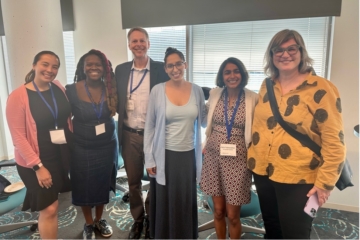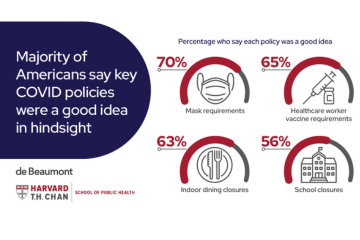In 2021, one in four public health workers was considering leaving their organization in the next year; 44% were considering leaving or retiring within the next five years. The COVID-19 pandemic called on public health workers to respond – to rapidly develop systems to track cases; guide public health responses; collect and disseminate information; establish testing, tracing, and vaccine systems– and maintain baseline public health functions in communities. The workload of public health employees increased exponentially, and it occurred amidst the highest levels of uncertainty and stress throughout society. After two years of responding to COVID, stress and work overload/burnout were top reasons for those considering leaving their public health jobs.
What is Burnout?
Burnout is defined as an occupational syndrome resulting from chronic workplace stress, causing emotional exhaustion, depersonalization, and a low sense of personal accomplishment at work. It can result from unmanageable workloads and poor workplace culture. But the concept of “chronic workplace stress” fails to fully grasp the experience of public health workers.
Public Health Workers’ Experience During COVID
Even before the pandemic, national organizations including Trust for America’s Health and the Institute of Medicine (now the National Academy of Medicine) had raised the cry for the underfunding of the public health system. As a result of this chronic underinvestment, the public health workforce was left understaffed and under-resourced to face a once-in-a-lifetime public health emergency.
Public health workers also faced unprecedented harassment and threats when providing recommendations and information on the need for preventative measures (e.g., wearing a mask or getting a vaccine). Over 40% of public health executives reported feeling bullied, threatened, or harassed. Public health workers also found themselves in the middle of the politicization of the public health response, and some very publicly shared experiences of being asked to manipulate data and ultimately being fired for trying to report accurate data.
The politicization of public health during the pandemic also reached into our nation’s highest public health institution with concerns that political and business interests were driving decisions made by the Centers for Disease Control and Prevention (CDC). Whether true or not, even the perception of such is harmful to both the public and public health workers. This politicization combined with early and ongoing missteps in communication further led to an erosion of trust in public health agencies, with only 34% of the public positively rating the nation’s public health system.
In Black and Latino communities, historical and ongoing discrimination in health and public health further contribute to greater distrust. Many Black and Latino individuals had valid questions about the vaccine, its development, and potential side effects that they felt were not properly addressed. Diverse teams can help to bring the perspective of thought needed to address complex public health problems and rebuild trust. While the public health workforce overall has grown more diverse in the last few years, there is much less diversity in senior and executive roles.
What is Moral Injury?
Moral injury was first described in military veterans who had been put into situations where they had to perpetrate, fail to prevent, or witness events that contradicted their deeply held moral beliefs and expectations. Similarly, moral injury for clinical health workers has been defined as “simultaneously knowing what your patients need and being unable to get it for them because of constraints outside of your control.” Applying the definition to public health workers could be as simple as exchanging the word community for patients.
It’s important to recognize that the experience of moral injury is more than feeling the traditional symptoms of burnout. Public health workers – as a result of underfunding leading to understaffing, and under-resourcing and politics leading to distrust and harassment – are not only exhausted from the workload of addressing a global pandemic, but they also feel a sense of betrayal by their organizations, government, and the public. They not only feel a sense of depersonalization and lack of accomplishment; they are frustrated, angry, and may feel hopeless.
Addressing Public Health Worker Burnout and Moral Injury
Ultimately, the solutions to addressing public health worker burnout and moral injury overlap, and will largely be built on increased investments in public health systems to ensure sufficient staffing, resources, support, and infrastructure for workers to effectively do their job. However, when 56% of public health workers are reporting symptoms of post-traumatic stress disorder, we also need to acknowledge their experience of moral injury and the root causes; and begin the process of not only rebuilding trust with the public, but rebuilding the trust of public health workers with their organizations and the system.
Randl Dent, PhD, is a Research Scientist with the Fitzhugh Mullan Institute for Health Workforce Equity at George Washington University (GWU) and a lead researcher for the Workplace Change Collaborative, a Health Resources and Services Administration (HRSA)-funded technical assistance center focused on supporting the Health and Public Safety Workforce Resiliency Training Program (HPSWRTP) and Promoting Resilience and Mental Health among the Health Professional Workforce (PRMHW) grantees in their efforts to promote wellness, reduce burnout and moral injury, and create better work and learning environments.
Candice Chen, MD, MPH is an Associate Professor in the Fitzhugh Mullan Institute for Health Workforce Equity in the GWU Milken Institute School of Public Health and the Project Director for the Workplace Change Collaborative.
The Workplace Change Collaborative (formally named the Health and Public Safety Workforce Resiliency Technical Assistance Center) is supported by HRSA of the U.S. Department of Health and Human Services (HHS) as part of an award totaling $5,940,548 with zero percentage financed with non-governmental sources. The contents are those of the author(s) and do not necessarily represent the official views of, nor an endorsement, by HRSA, HHS or the U.S. Government. For more information, please visit HRSA.gov.





